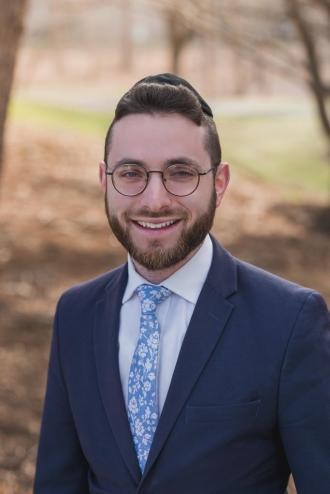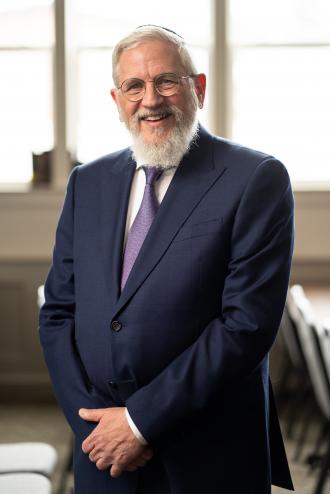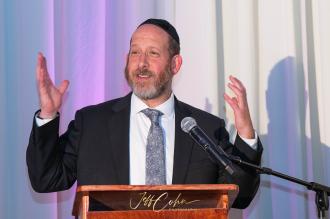This article originally appeared in Jewish Action magazine, Summer 2022 issue. Reprinted with permission.
Although it’s been three years since she worked as a teacher, Zissy Friedman is often stopped enthusiastically by former students when she’s out and about in Lakewood, New Jersey. As an elementary school general studies teacher for twelve years, Friedman loved teaching children and bringing out the best in them. She felt trusted and supported by the schools she worked in and appreciated the professionalism of her fellow teachers. “It’s sad that I left teaching,” she says, “but it didn’t work for me as a frum mother.” Because general studies teachers work in the afternoons, Friedman found it was a constant struggle to figure out child care for her children; if one of her children was sick, it felt like a calamity. “By definition, teaching comes with very specific hours in the classroom and no flexibility. Unfortunately, [being a general studies teacher] is just not a family-friendly profession,” she says. Teaching also required her to invest significant amounts of time outside school hours. “A lot of time goes into a well-run classroom. As my kids got older, I didn’t have that time.”
Friedman tried to stick it out, but “the scheduling and the finances weren’t working anymore.” She now devotes her time to her freelance writing business—which she had initially begun in order to supplement her teaching salary. “My school lost five great teachers the year I left,” she recalls. At least three quit because their second job ultimately “made more sense. None of us was happy to leave teaching, but we felt the choice had become obvious.”
Friedman’s decision is indicative of an alarming trend in recent years. The Wall Street Journal reported that the rate of people quitting jobs in private educational services rose more than in any other industry in 2021, according to federal data. On the professional networking site LinkedIn, the number of teachers who began a new career increased by 62 percent last year. Within the Orthodox Jewish community, the challenge of teachers leaving the profession is compounded by a notable lack of people entering the field. This reality is affecting all types of Orthodox Jewish schools across North America, and the shortage of teachers is reaching crisis proportions.
Never Enough
While the overall lack of teachers has become a serious challenge more recently, the problem of finding limudei kodesh teachers in Modern Orthodox and community day schools is not new, according to Rabbi Zvi Grumet, who holds an EdD from Yeshiva University’s Azrieli Graduate School of Jewish Education and Administration and is director of education at The Lookstein Center at Bar-Ilan University. However, he explains that “in the past two years the problem has become more acute” as two trends have intersected: a shrinking pipeline of new teachers and an exodus of seasoned teachers as a result of the pandemic.
“Every time a teacher retires the entire leadership team cringes,” says Adriane Mittan, executive director of the Hebrew Academy of Long Beach on Long Island. “It doesn’t even matter what the particular position is.” The shortage seems to affect teachers on all levels, “from assistant teacher to directors of departments,” she says.
At Azrieli, Dean Dr. Rona Novick sees a “deluge of requests for educators.” Schools seem to be desperate for good candidates. “Outside of the New York area, the desperation is even greater,” she says.
With about forty graduates—both men and women—in a typical year, Azrieli is the largest graduate-level program preparing Judaic studies educators to teach in Jewish day schools. Azrieli offers a master’s degree in Jewish education with in-person programs on its Manhattan campus, or fully online for those who are working full time or are outside of New York. While Dr. Novick has not seen a decrease in applicants or graduates over her six years as dean, the program certainly isn’t operating at full capacity. “We were never producing enough teachers,” she says. “We could accommodate three times the number of graduate students we have now. They would be welcome, and they would find jobs.”
Dr. Novick notes that each year, a percentage of Azrieli graduates make aliyah. “These teachers are lost to North American education,” she says. Rabbi Grumet adds that this phenomenon has caused significant attrition in the field over the past thirty years. “The same passion and idealism that motivated them to become teachers inspires them to move to Israel,” he explains, admitting that he himself followed that path when he made aliyah in 2001.
Another consistent phenomenon, says Dr. Novick, is that many good teachers leave the classroom to move into administrative roles in schools. This trajectory, she adds, is largely a function of higher salaries in leadership positions.
The issue of low salaries is a commonly acknowledged reality that deters young people from going into education. While the challenge isn’t new, higher costs of living in frum areas—and often, higher standards of living—make a career in Jewish education seem unrealistic to many young people. Historically, there was an assumption in the Jewish community that rebbeim and morot saw education as a “calling” and were therefore prepared to make do with less. “Mesirut nefesh for chinuch is not there anymore,” says Rabbi Mordechai Shifman, head of school at Emek Hebrew Academy in Los Angeles. “Honestly, I don’t know that people in chinuch are struggling more now than they did twenty years ago. But young people are more focused on achieving financial independence—and that is guiding their decisions.”
While teaching may never become a high-income profession, the subject of raising teachers’ pay has begun to move to the forefront of communal discussions—it was a primary focus of Torah Umesorah’s convention in the fall of 2021—causing new pressures for schools. “They are balancing the thorny issue of high tuition with the desire to pay respectable salaries to teachers,” says Dr. Novick. “It’s a very real challenge.” She believes, however, that the matter has implications that go far beyond dollars and cents. “Compensation is the primary way of showing what we value, and teachers have the most important jobs in the world. As a community, we must find creative solutions.”
While teachers’ wages have remained low, their job has only become more challenging. “Teaching is unquestionably harder now than when I started in the field thirty-six years ago,” says Deena Rabinovich, a chair of the Judaic Studies Department at Stern College and a professor at Stern College and Azrieli. “Differentiated learning means preparing more lessons for every class. It’s normal to have children in mainstream classrooms with all types of challenges, and the teacher has to juggle it all. On top of that, many schools require teachers to post homework online. All of that is extra work that falls to the teacher to manage.”
“Classrooms today are more demanding,” says an expert in Jewish education who prefers to remain anonymous. “More students have significant social-emotional needs, and these issues are taking center stage in the classroom. The emotional labor of teaching cannot be measured. Word has gotten out: This is hard work.”
Restoring a Sense of Mission
One pivotal, if overlooked, factor in the discussion is the lack of idealism.
“To be a Jewish educator and to be successful, it must be a calling for the individual,” says Rabbi Dr. Tzvi Hersh Weinreb, executive vice president, emeritus of the OU and a trained psychologist. “One must have a mission. It must be his or her life passion. You can’t be motivated by money to be in this field. Unfortunately, many in today’s generation are focused on materialism and acquiring wealth. I’m not sure what can be done to redirect young people to think about pursuing careers in Jewish education. No matter how much we try to fill the financial gap, there will always be a gap. The sense of mission is key.”
Rabbi Weinreb further explains that educators will often consider teaching on the high school or beit midrash level but not the younger grades. “The mitzvah of talmud Torah,” he says, “doesn’t necessarily mean teaching at the highest level. From a pure Torah standpoint, there is nothing more valuable than teaching tinokos shel beis rabban. I see young Chassidic men and women who teach first, second or third graders and they are supercharged with enthusiasm. These educators recognize the value of what they are doing. Their community gives them this sense of mission and purpose,” he says. “We have to do a better job of imbuing our young people with that same sense of mission and purpose.”
Growing the Pipeline
Dr. Novick is continuously involved in efforts to recruit passionate college students to become teachers. “We are always working to get the word out, encouraging undergraduates to consider a career in Jewish education,” she says.
Yeshiva University has numerous efforts and innovative programs to attract and inspire young people to become teachers. For example, the Legacy Heritage Jewish Educators Project, which Rabinovich directs, allows Stern students to fast-track their professional training to become Jewish studies teachers. “The goal of this program is to make professional training as streamlined and cost effective as possible,” says Rabinovich. Thanks to philanthropic support, the program also offers significant scholarships—in exchange for a commitment to teach at a Jewish school in North America for two years after graduation.
Despite efforts like these to grow the pipeline of qualified Jewish educators, in some parts of the country it feels like too little, too late. “In LA, it’s been a difficult problem in the past but nothing like what we’re seeing now,” says Rabbi Shifman. “I know there were schools functioning halfway through the school year with some positions unfilled. We were able to fill all of our positions this year, but it’s a real concern for next year as the school, baruch Hashem, continues to grow.”
Jewish schools, he notes, face a challenge attracting general studies teachers, who compare the salary and benefits to what the public school system offers. With limudei kodesh teachers, he says, there is an entirely different issue. “The challenge is paying our morot what they deserve,” he says, noting that his school has raised salaries quite significantly over the past ten years. “There used to be an assumption that a morah was earning a supplementary income for her family. That is no longer the case. Salaries need to be equitable, and we are working on fixing that.”
Rabbi Shifman describes a scenario he sees frequently. Young women come back from seminary and take a teaching job at an entry-level salary. “In most cases, the morah is living at her parents’ home, often taking college classes at night,” he says. “She is gaining professional experience while living comfortably.” By contrast, most new rebbeim only begin looking for teaching positions after spending some number of years learning in kollel; at that point, they have a family to support. “Because there are no post-high school yeshivot in Los Angeles, our candidates are not local,” explains Rabbi Shifman. “Taking a job here means moving one’s family to the West Coast. Despite having little to no training or experience, they’re simply not going to do that if they don’t have a job lined up with a living wage. So in general, rebbeim get a better deal.”
As part of creating the most attractive salary package possible for new teachers, Rabbi Shifman says he aims to hire mechanchim who will send their children to Emek. “Not only is this, in my opinion, a hashkafically sound approach but it allows us to offer a tuition break, which is a big benefit.” Most Jewish day schools offer their staff significant discounts if they send their children to the school, ranging from a 20 to 90 percent reduction in tuition—depending on how many hours the teacher works and other factors. For some schools, the arrangement works really well. At Barkai Yeshivah in Brooklyn, for example, Executive Director David Chalom says parents comprise about half of his staff. “We give our staff members a staff discount; it’s working for their lifestyle and it’s working for the school economically.”
Rabbi Shifman is also keenly aware of the need to address the issue of housing costs when trying to recruit teachers. “Sky-high housing prices is the biggest problem facing the community in LA,” he notes. “We are fortunate to have ba’alei batim who are willing to help with acquiring properties.” The caveat, he adds, is that the model of offering an attractive compensation package “really works best if we can find a couple who are both high-quality educators.”
At the end of the day, Rabbi Shifman believes that for Jewish education to be available to our children, communities are going to have to come up with solutions together. “Schools cannot afford to buy houses to attract teachers,” he says. “In every frum community, attracting and retaining teachers cannot be viewed as the issue of the school alone to solve. Everyone stands to benefit when mechanchim live within the community because the spiritual level of the community is raised. There needs to be more of a grassroots push to make it work.”
In light of the shortage of teachers in Orthodox schools, one initiative underway to recruit more young people into the field of education is MafTeach. Sponsored by Yeshiva University, the one-year fellowship program for undergraduates who are not necessarily in education programs apprenticed young people and gave them a taste of teaching, according to Professor Deena Rabinovich, who oversaw the program. Each student was adopted by a school outside of New York and traveled to teach and spend time in the community. “Many of the participants gained a real appreciation of what it means to teach,” says Rabinovich. The fellowship was paused due to the pandemic, but plans are underway to resume this coming fall.
Raising Funds to Raise Pay
While Modern Orthodox and out-of-town schools struggle to find Jewish studies teachers, the challenge facing Chareidi schools in the tri-state area is quite different. “In these schools, it’s not a limudei kodesh issue at all,” says an expert in Jewish education. “We are seeing a much greater challenge in general studies.” As a rule, she explains, schools have kodesh classes in the mornings, and those hours tend to be better for working mothers.
“We’ve definitely seen some creative ideas to solve the problem,” she adds. For example, some schools have begun offering on-site child care for staff. One school is offering the option of an afternoon preschool so children can attend school while their mothers teach general studies.
Even in out-of-town schools—which have historically been more comfortable hiring non-Jewish teachers for general studies—finding teachers has gotten harder. “On a recent visit to Cleveland,” says the expert, “a principal told me that when he used to post a job, he would get ten to fifteen candidates. Now he’s getting one or two responses at most.”
In 2021, Torah Umesorah kicked off a highly publicized campaign to raise awareness regarding the teacher shortage and the importance of this issue for our children’s future. The campaign highlighted the importance of having qualified teachers. And the organization threw out the challenge: “What are we as a community doing about it?”
The response was overwhelming, with donors contributing more than $25 million in just a few months to create a “superfund” for morot—across all subjects. A major focus of the fund is to increase teachers’ pay across the board. The goal of this initiative is to address the pervasive disparity between the salaries of morot and rebbeim.
Bnos Yisroel of Baltimore, a pre-K-through-twelfth-grade girls school, is one example of a school whose leadership had been looking for ways to increase their teachers’ wages. Thanks to a local initiative—inspired by Torah Umesorah’s national campaign—they now have a plan in place to make it happen. “The generous funding will match a portion of what we pay to raise our teachers’ salaries,” explains School Director Ahuvah Heyman. “At the end of four years, all of our full-time teachers will be making significantly more per year.” This program is part of a greater effort at Bnos Yisroel to convey to its approximately eighty teachers, “We value you, we need you and we want you here,” she says. Additionally, this year the school has begun offering a 403(b) retirement plan for the first time and has increased tuition remission for teachers who work more hours.
Heyman is upfront about the significant extra costs associated with increasing salaries and benefits for staff. “After the four-year commitment ends [from our funders], this will come with an annual $1 million price tag, which the school will have to fundraise,” she says. “People have asked us how we can manage that. Our answer is, ‘How can we not?’
“It’s definitely not simple,” Heyman admits. “It’s a big expense for schools. But we need to pay a respectable salary that shows how much we value our teachers. The future of Klal Yisrael starts right here.”
In It for the Long Run
While salary increases may go a long way toward encouraging teachers to stay in the field, most experts say that creating a culture of professional growth in schools is key to keeping teachers from feeling burnt out and ultimately leaving. “You’re only a teacher if someone is learning, and that requires expertise,” says Rabinovich. “When we put teachers in a classroom before adequately training them, it’s like staffing a clinic with doctors before they’ve gone to medical school”; they aren’t set up for success and are unlikely to stick with it. Unfortunately, many schools inadvertently create a catch-22 for teachers, she says. Teachers aren’t necessarily rewarded or incentivized for getting the training they need to teach well, and schools often don’t prioritize the budget or time required to offer their staff such opportunities.
As a veteran teacher, Rabbi Grumet is personally familiar with the feeling of burnout. “I had my own crisis many years ago,” he says. “I was teaching the same thing year after year, and I felt I wasn’t growing professionally. Teachers are often highly passionate and motivated. Schools need to consider how they can nurture those traits and create a culture of growth and development.”
If communities want to retain effective teachers, a final piece to consider is the expectations placed on teachers, which are “often unreasonable,” he notes. “Teachers are expected to be ‘on’ all the time.” Administrators, board members and parents want teachers to show up at every event outside of school hours. And parents expect their children’s teachers to be consummate professionals, but feel free to corner them at a kiddush or in the grocery store to discuss their concerns about their child.
Rabinovich suggests that schools offer training for parents on how best to partner with teachers—just as teachers are taught how to partner effectively with parents. “Unfortunately, parents often don’t respect boundaries when it comes to their child’s teacher,” she says. “We all know stories of parents calling the principal because they emailed the teacher half an hour ago and haven’t heard back yet,” she says. “What they don’t realize is that they don’t actually want their child’s teacher to be checking emails or responding to text messages during class.” She believes that communal boundary setting can help prevent teachers from feeling overburdened and disrespected.
To Dr. Novick, the question of how to show proper respect for teachers is both communal and also very personal. “I know of a community where the shul rav stands when a teacher walks into the room,” she says. “Is that the level of respect most of us are conveying? We have to do our own cheshbonot concerning how we talk about and treat educators, especially in front of our children. It would go a long way if we recognized the superhuman efforts of teachers, even if we have concerns.”
She notes that in the beginning of the pandemic, “there was a groundswell of support for Jewish teachers. It was so heartening. I thought maybe this window into the world of chinuch would change the conversation! But the following year, all unfettered criticism was back.”
Help Wanted
Community leaders are hopeful the teacher shortage problem can be solved in some way—whether through raising salaries, attracting more young people to the field or preventing burnout (through professional training and giving teachers the respect they deserve). But in the meantime, the challenges to the entire Jewish educational system are continuing to grow. “Schools need to staff every classroom, so they put someone in the room,” says Dr. Novick. “But then children and parents encounter teachers who are less than qualified and our schools’ professionalism and children’s education are undermined.”
“With some creativity, there has to be another way,” other than filling classrooms with whomever the school can find, says Rabbi Grumet. “Maybe this is the perfect opportunity to rethink classrooms. Maybe it’s time to stop thinking about teaching and start thinking about learning.” Put simply, Rabbi Grumet believes if we pay more attention to how the students are learning instead of how teachers are teaching, that can lend itself to rethinking classrooms.
In the meantime, Zissy Friedman doesn’t see the situation for teachers changing any time soon. “A family friend is back from seminary and she’s working as a teacher,” she says. “She’s a wonderful teacher; she’s great at it. And yet she’s looking into getting a degree in accounting.”
But Friedman is hopeful that at some point in the future, teaching will make sense for her again. “I’d go back in a second if I could,” she concludes.
SIDEBAR:
No Better Place to Be
By Rachel Schwartzberg
“We truly believe there’s no better job for a Jewish woman than being a teacher,” says Ahuvah Heyman, school director at Bnos Yisroel in Baltimore, a girls school with over 500 students in preschool through twelfth grade. This approach is more than just a matter of staffing classrooms; it’s a worldview. And Heyman is passionate about it. “Working in a school allows a parent to structure her life around her family. A teacher works in a wholesome environment and has a job that identifies with the centrality of children in our lives.”
As far as the issue of teachers’ historically low pay, thanks to generous donors, Heyman’s school will be raising teachers’ salaries. “Once we raise our teachers’ salaries over the next few years, they’ll be earning the hourly equivalent of a full-time job that pays $100,000 for year-round employment,” she explains. “However, most of our teachers work part time, which is their preference, and for fewer than ten months of the year.”
The additional family-friendly perks of teaching in a Jewish school are often overlooked, she believes. “Teachers have thirty-seven paid vacation days [such as when school is closed for yamim tovim], and they get personal days on top of that. We have on-site day care at our school and tuition remission as well. These benefits highlight how wonderful it is to work in a school environment—and we should be talking about them more.”
SIDEBAR:
A Higher Calling
By Rachel Schwartzberg
Ora Rubin often heard a similar refrain when people heard she wanted to be a teacher: young men who plan to learn in kollel might not even consider dating a teacher—they are interested in women with a more lucrative and “easy” career path.
“Fortunately, that wasn’t my experience,” says Rubin. Now married with two small children, Rubin is in her second year as a Pre-1A (kindergarten) morah at a girls’ school in Queens, New York. “My family was very supportive of my chosen career,” she says. “Many of my relatives are in education, so it didn’t come as a shock to them that I chose this field—even though it’s not a common path anymore.”
Rubin was inspired to become a teacher by her own personal experience. “My father is in Jewish education,” she explains. “That was our life when I was growing up—not just my father’s but my whole family’s. I saw that chinuch was very meaningful to my parents, and it became meaningful to me as well. There is no greater privilege than teaching Torah.”
Rubin admits that she takes her work home with her every day, putting in a lot of time beyond school hours, time she wishes she got paid for. “At night, I’m speaking to parents; I’m doing lesson planning,” she says. Nevertheless, she loves her job. “I work in a school that challenges teachers to make learning exciting for the students,” she explains. “Every day in the classroom looks different. Working with preschoolers, I feel I’m laying the foundation for their life skills, which is a very special way to spend my days. I hope I’ll continue to feel this way.”
Rachel Schwartzberg is a writer and editor who lives with her family in Memphis, Tennessee.














